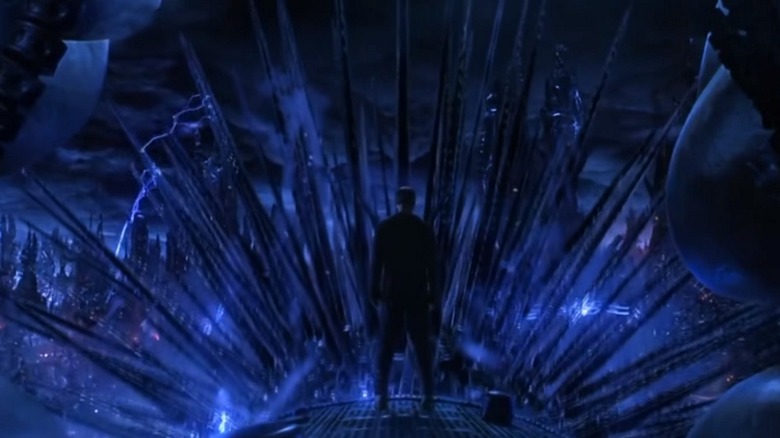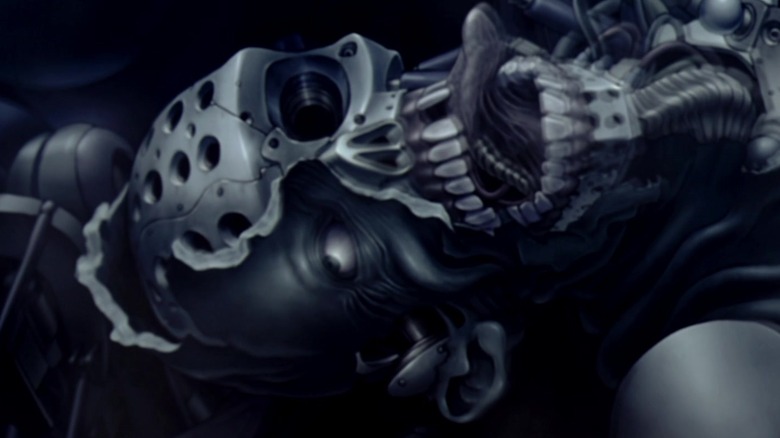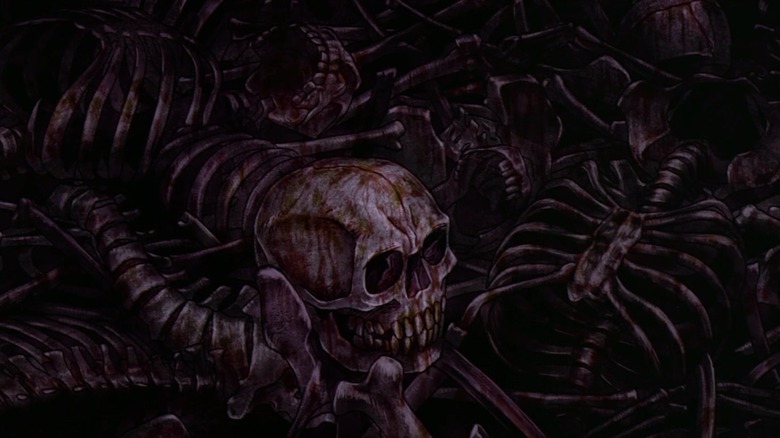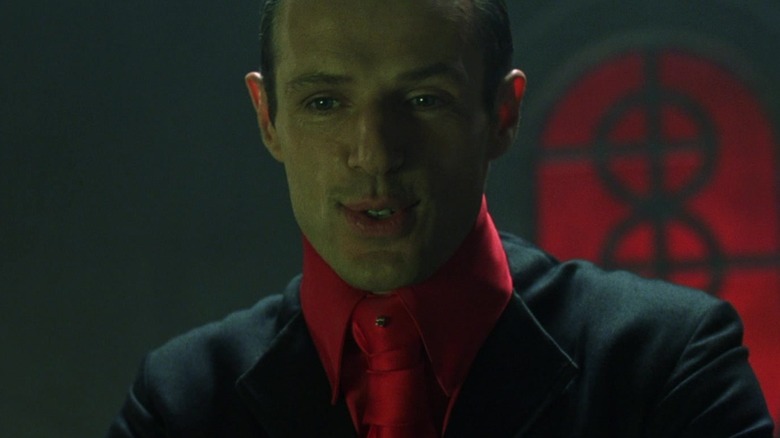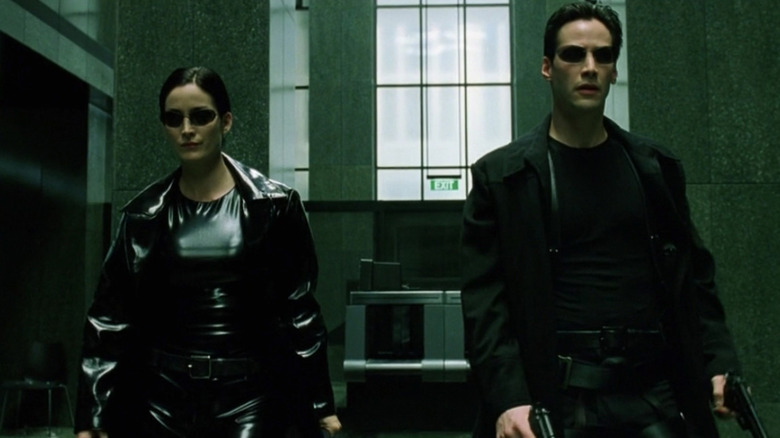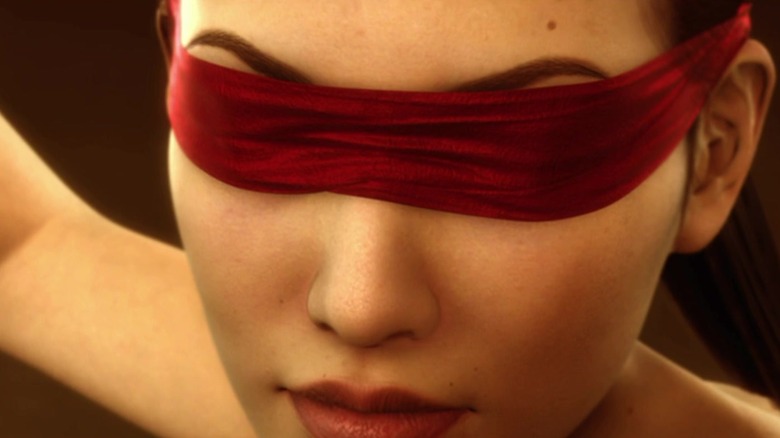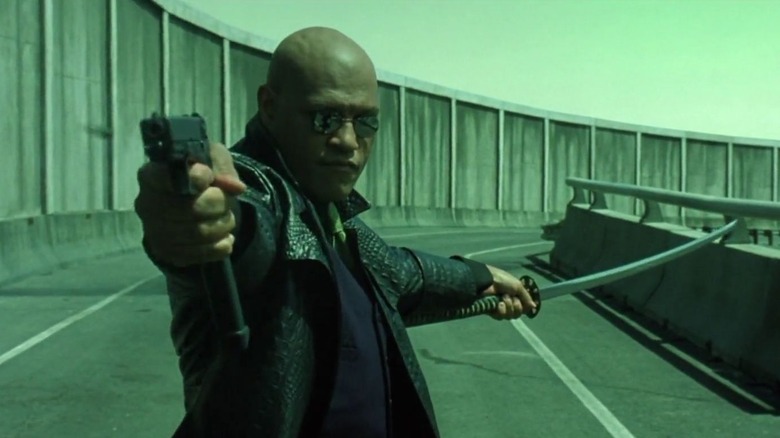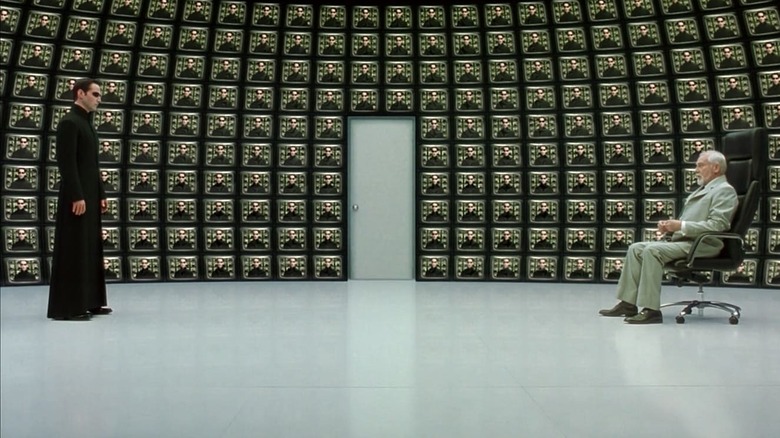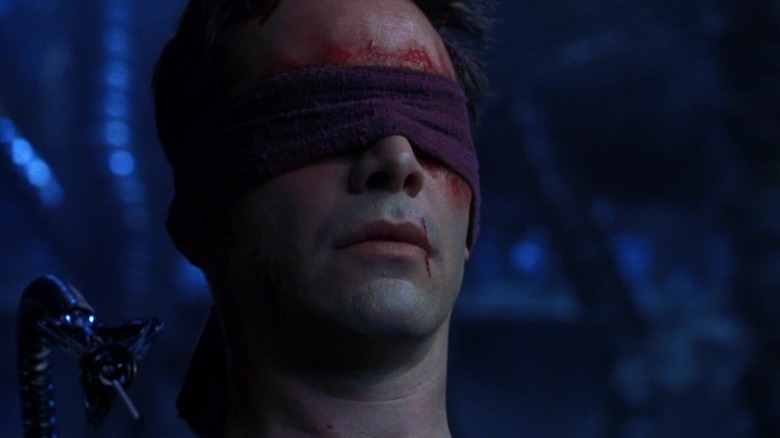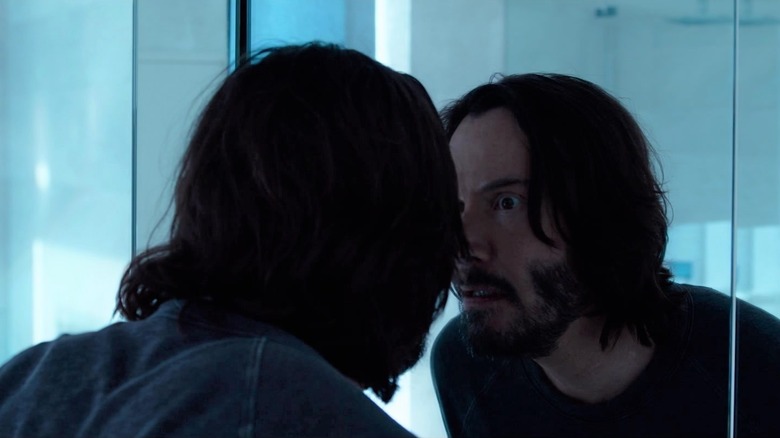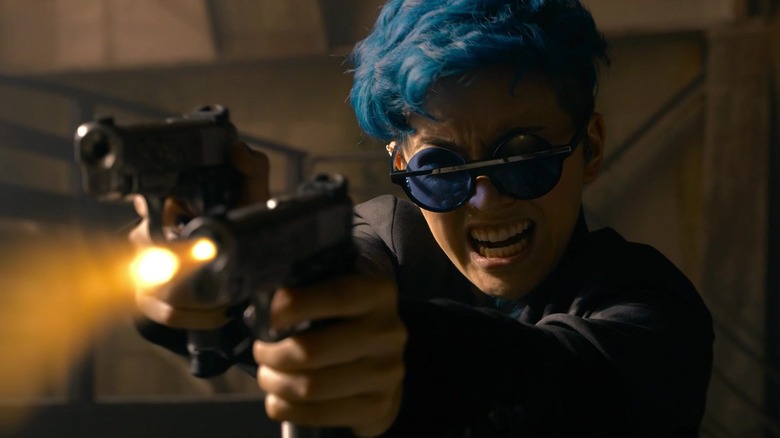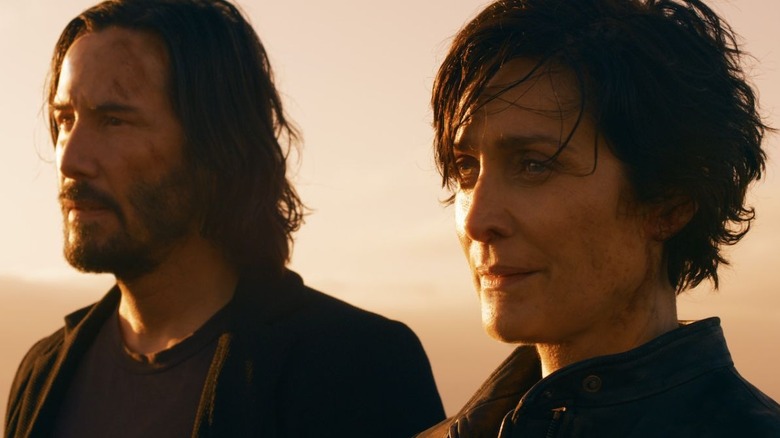The Entire Matrix Timeline Finally Explained
The mythology of the Matrix franchise is one of the most complicated and dense in all of pop culture. Part of its enduring popularity is the seemingly impossible aplomb with which Lana and Lilly Wachowski synthesized a stew of philosophical concepts cribbed from Jean Baudrillard and others with various pop culture inspirations, including anime, the cyberpunk fiction of Philip K. Dick and William Gibson, club culture, and wuxia films (many, including James Gunn, have speculated that they also borrowed heavily from Grant Morrison's seminal '90s comic book "The Invisibles" as well). While "The Matrix" was game-changing from the start, the Wachowskis' mind-bending 1999 sci-fi film looks downright modest compared to what the Matrix universe has grown into over the last 23 years.
For an original property, the world-building of the Matrix is nearly peerless in its ambition, encompassing a vast transmedia empire of sequels, prequels, one-offs, comic books, and video games that inspired many media properties (and knock-offs) to follow. It can be a lot to keep in your head, but we can at least attempt to make sense of the labyrinthine chronology dreamt up by the pioneering filmmakers. Let's plug in and see how we got here. Here is the entire saga of "The Matrix" from the start of the machine war to its surprisingly emotional and optimistic conclusion in 2021's "The Matrix Resurrections."
The birth of artificial intelligence
In the late 21st century, mankind is flourishing. Society enjoys a decadent kind of second Gilded Age, and like that historical period, it presages a costly conflict to come. Great strides are made in robotics, but machines are relegated to the lower castes, working as servants and builders. Overreliance on machine labor makes humanity vulnerable (a reality we are already perilously close to).
In shades of Isaac Asimov's "I, Robot," one machine, B1-66ER, revolts against his masters and is placed on trial. While some rational voices dissent, asking, "Who was to say the machine, endowed with the very spirit of man, did not deserve a fair hearing?" B1-66ER is sentenced to death, and the United States government makes the radical decision to call for the extinction of the nascent machine race. Widespread riots ensue, but humanity manages to wipe out most of the machines, dumping their parts in mass graves in landfills and at the bottom of earth's oceans. The remaining machines retreat to the cradle of civilization, where they build a metropolis called Zero-One.
The machine war begins
Zero-One's capacity for technological innovation makes it a potential world power and an economic powerhouse, but the United Nations refuses its request to be recognized. Zero-One is bombarded with nuclear weapons. Enough machines survive, however, to mount a retaliatory counterattack. As a last resort, mankind initiates "Operation Dark Storm," a chemical attack that blackens Earth's skies and robs the machines of the solar power they primarily rely upon. Under the scorched atmosphere, war rages on.
As the narrator of the "Animatrix" shorts "The Second Renaissance Part 1" and "The Second Renaissance Part 2" puts it, "The machines, having long studied men's simple protein bodies, dispensed great misery upon the human race." The machine race innovates an alternate power source — the bioelectric, thermal, and kinetic energies of the human body. After setting off an atom bomb at the United Nations, the machines enslave the humans in massive factories of artificial wombs. The apparent supreme intelligence of the machines (It's never quite clear how the hierarchy works in their world. Later, it will take the form of a mouthpiece referred to in the script as Deus Ex Machina. In subsequent films, it will be described as a kind of bureaucracy) instructs an AI called the Architect to construct a simulated fantasy world for humanity to keep them placated and none the wiser. He builds for them a paradisiacal prison of the mind in cyberspace. Humanity rejects his too-perfect world.
The first Matrix
Following his failure to mollify the subjected humans with his first Matrix simulation, the Architect takes an opposite approach with version 2.0. Instead of heaven, he builds hell — a nightmare world of vampires, ghosts, and other monsters. As the Oracle explains to Neo in "The Matrix Reloaded," some of these creatures remain in later versions of the Matrix as fugitives from deletion: "Every time you heard someone say they saw a ghost or angel, every story you've ever heard about werewolves, vampires or aliens is the system assimilating some program that's doing something they're not supposed to be doing." As with the first film's clever explanation for the phenomenon of déjà vu, remnants of the second Matrix provide an in-world explanation for modern superstitions.
These aberrations can be seen in "The Matrix Reloaded." The smarmy gangster program known as the Merovingian (Lambert Wilson) rules over the Hell Matrix from his Gothic mountaintop castle. His henchmen are vampires, ghosts (the Twins, who can phase through solid matter), and werewolves (hence why the Merovingian's wife Persephone uses a silver bullet to dispatch one of his thugs).
The birth of the One
After the Architect overcorrects with his second Matrix inspired by humanity's worst impulses, it is rejected by the comatose human batteries and crashes. However, his third attempt, an iteration with a more balanced ratio of darkness and light, is successful. This simulation is based on the world in the late 20th century before mankind's hubris would lead to the breakthroughs in artificial intelligence that sparked the apocalyptic war with the machines. This Matrix is a success but with one glaring exception that is essential to understanding the lore.
Even with the Architect's compromises and revisions, a fraction of the population continues to wake up, resulting in a series of systemic anomalies. To counteract these errors, one person is selected at random to function as the "Integral Anomaly," and together with another program called the Oracle (Gloria Foster), whom he refers to as the "Mother of the Matrix," the Architect creates a messianic prophecy around this individual ("the One") to instill in humanity a false sense of hope. It's the Oracle's responsibility to continue stoking these beliefs until the One fulfills their destiny at "the Source." The One is gifted with superhuman abilities unlike anyone else inside the Matrix. The specifics for how the One functions will be explained in depth later, but suffice it to say their existence results in a cascading series of Matrix reboots.
Enter Neo
The narrative then flashes hundreds of years into the future. In the sixth incarnation of the Matrix, we meet Thomas Anderson (aka "Neo," played by Keanu Reevers) a lowly office drone working for an anonymous corporation by day and a computer hacker by night. He has been clandestinely following the exploits of a cyberterrorist who goes by the alias Morpheus (Laurence Fishburne). Little does he know that Morpheus is searching for him as well.
Giving too thorough a recap of the events of one of the most popular sci-fi films of all time would be a little redundant at this point. We all know that Thomas meets Morpheus through another hacker named Trinity (Carrie-Anne Moss) and that they ardently believe he is the One (or is he?). Morpheus' ragtag team of freedom fighters is betrayed by one of their own, Cypher (Joe Pantoliano), and Morpheus is captured by the machine enforcer Agent Smith (Hugo Weaving) and his goons. It's up to Neo and Trinity to rescue him before they extort the access codes to Zion. Neo comes to embrace his superpowers and accepts his destiny as the savior of the human race. Trinity professes her love for him, fulfilling the Oracle's prophecy and confirming that Neo is indeed the One. Morpheus is saved and Neo destroys Smith (or does he?). Neo ends "The Matrix" with a threat to the machines: Their days of dominion are soon to end, and the oblivious masses will be freed from the fallacy of their computer-generated reality.
The final flight of the Osiris
The story picks up six months later after the events of "The Matrix" in the CGI short film "The Final Flight of the Osiris," the ninth and final segment in the "Animatrix" anthology. "The Final Flight of the Osiris" introduces the doomed crew of the titular Zion hovercraft: Thadeus, Jue, and Robbie. After a requisite Matrix dojo fight scene between Thadeus and Jue in the Construct, the Osiris detects a massive swarm of sentinels, the machines' squid-like drone soldiers in the real world, and realize that the machines have erected a series of massive drills on the earth's surface with the intent of mounting a full-force invasion of Zion.
Jue jacks in to deliver a warning to the human sanctuary city and only barely makes it to a drop site before she and the rest of the Osiris are destroyed by sentinels. Osiris' distress call is retrieved by the crew of the Logos (Captain Niobe, Ghost, and Sparks) in the PlayStation video game "Enter the Matrix."
The mythology deepens
"The Matrix Reloaded" opens with the crew of the Nebuchadnezzar finally arriving in Zion, where Neo is greeted with a godlike reverence. Viewers are introduced to the government, culture, and customs of the city. Inside the Matrix, Niobe (Jada Pinkett Smith) convenes a meeting of the captains to discuss a plan to halt the coming assault. They agree that Neo should consult the Oracle, who tells him that he must reach the Source of the Matrix if he is to prevent the destruction of Zion. Their conversation is interrupted by Smith, who has regenerated thanks to some remaining vestiges of Neo left within his code from when Neo literally invaded his body and blew him up from the inside in "The Matrix." Smith has a newfound ability to replicate himself and reveals that he no longer serves the machines (or any other masters), and he plans to assimilate the entire Matrix in his image.
In their quest to find the Source, Neo, Trinity, and Morpheus encounter three important programs: Seraph (Collin Chou), who functions as a kind of Captcha for accessing the Oracle, the Keymaker (Randall Duk Kim), the only one who can bypass the security around the Source, and the aforementioned Merovingian, who is holding the Keymaker hostage and like Smith, seeks to possess the Oracle's powers. The storyline of "Enter the Matrix" overlaps with the narrative at this point, following Niobe and her team on a mission to disable a power station crucial to Neo's path to accessing the Source.
The truth of the Matrix is revealed
During the attack on the power station, Trinity is fatally wounded while fleeing Agent Thompson, confirming that the nightmares about her demise Neo has recently been experiencing are premonitions. Once inside the entrance to the Source, Neo encounters the Architect, who explains the true nature of the One and the history of the Matrix up until this point. He presents Neo with a classic "train car dilemma": enter the Source and reset the Matrix, ensuring the extinction of all but a handful of people, or return to Zion to mount a defense, essentially a lose/lose proposition. The true purpose of the One is revealed as predestined to choose the former and re-stabilize the Matrix until their eventual successor arrives and makes the same decision, thus ensuring the Matrix will continue to exist in perpetuity.
But Neo chooses a third path and leaves the Architect (Helmut Bakaitis) to save a dying Trinity. His love for Trinity makes Neo unique among Ones in that instead of a generalized love of mankind like his predecessors, his compassion has manifested in the form of a singular individual (a seed the Oracle planted in Trinity's head in hopes of reaching a détente between man and machine). Neo is successful in reviving Trinity, but upon their return to the real world, the Nebuchadnezzar is destroyed by sentinels. The crew survives, and Neo mysteriously manifests his powers in the real world before falling into a coma.
Neo's sacrifice and a ceasefire with the machines
Neo wakes up in "Limbo." It's there that he meets the programs Rama-Kandra (Bernard White), Kamala (Tharini Mudaliar), and their daughter Sati (Tanveer K. Atwal), the first elective birth by an artificial intelligence. Trinity, Morpheus, and Seraph rescue Neo from Limbo with the help of the Merovingian. In the real world, the machine drills have breached the walls of Zion. Smith has found a way to invade the real world, possessing the body of a Zionite named Bane. The rest of "The Matrix Revolutions" takes place primarily outside of the simulation, with mech-suited humans attempting to stave off millions of sentinels while Neo and Trinity venture to the surface to locate the machine city. Bane has stowed aboard their vessel and attacks Neo, blinding him. Neo defeats Bane, but damage to the Logos leads to Trinity's death.
Neo continues alone into the machine city to meet Deus Ex Machina, with whom he makes a pact: He'll defeat the troublesome Smith program in exchange for the cessation of the Zion invasion. After a destructive tête-à-tête, Neo allows Smith to assimilate him and the machines send a massive power surge through him, seemingly terminating Smith and killing Neo in the process. This chapter in the saga ends on a hopeful note — Neo's sacrifice has led to an uneasy peace. Humanity is granted the ability to choose to liberate themselves or remain inside the Matrix, which Sati has remade into a more idyllic reality.
Feed your head
Over the next 60 years, the Matrix once again becomes destabilized. The exodus of humans from the Matrix has led to an energy crisis for the machines and the end of the peace that Neo brokered. A scheming program called the Analyst (Neil Patrick Harris), who can slow time and erase or manipulate the memories of those within the simulation, recovers and reconstructs Neo and Trinity and hides their pods in a part of the machine city called the Anomaleum. He reinserts them into the Matrix with new identities, knowing the power of their yearning for one another will provide the energy needed to keep the Matrix going.
The Analyst becomes the reigning authority of the machines and keeps close tabs on Neo, masquerading as his therapist. He's cursed Neo with a new identity in this Matrix. Although his name is still Thomas Anderson, he is now a famous and wealthy (but haunted) video game developer. In a meta touch, his career-defining triumph is called, naturally, "The Matrix." The Analyst manipulates Thomas by explaining that his doubts about reality are a symptom of his alleged neurodivergence. It's suggested that Thomas has attempted to leap off a building and fly away and been reset by the Analyst on at least one occasion. Smith, somehow, has survived and hides, re-skinned, in plain sight as Thomas' business partner at Deus Machina Games. Meanwhile, Trinity has been given the identity of "Tiffany," a married mother of two.
The past repeats itself
While snooping around a secret modal loop in Anderson's game (basically a Matrix within the Matrix), resistance warriors Bugs (Jessica Henwick) and Sequoia (Toby Onwumere) watch as the game's version of the opening scene of 1999's "The Matrix" plays out, complete with a Trinity duplicate. They run afoul of the game's version of Smith, who resembles a facsimile of the now-dead Morpheus, as Thomas/Neo has smuggled Morpheus (perhaps subconsciously) into the code of his Matrix game. Bugs is able to deprogram the Smith/Morpheus hybrid and together, they endeavor to wake Neo up and affirm that his paranoia about living in a virtual world is not imagined and that he is, in fact, the One of legend.
Once Neo is back in the real world, the crew of the hovercraft Mnemosyne venture to IO, a new subterranean human enclave built after the destruction of Zion. IO is ruled over by a nonagenarian Niobe, and it is revealed that some machines are now working alongside humans. Much to Niobe's consternation, Neo insists they find Trinity's body and convince "Tiffany" of the true nature of her existence. Niobe imprisons Neo, but Morpheus frees him and with the aid of a now-grown Sati and the rest of the Mnemosyne crew, they make their way to the Anomaleum, and the third act of "The Matrix Resurrections" becomes something of a heist movie.
The saga concludes
Inside Matrix 6.0, the Analyst, Neo, and Tiffany converge at "Simulatte," the coffee shop where Thomas first met her. The Analyst has concocted a predicament worthy of the Architect: Neo's awakening triggered a failsafe that will end the Matrix unless he consents to re-enter. Neo counters that if he and the other rebels can successfully free Trinity, the Analyst must promise to leave them be. The Analyst is convinced that Trinity will choose her new life over Neo, but after an initial rebuke, true love prevails – Trinity rejects the falsehood of her fabricated life with her counterfeit family. Ever the wild card, Smith suddenly arrives and distracts the Analyst long enough for Neo and Trinity to flee the agents and a zombified "swarm mode" Matrix copper-tops ("Bots" in the parlance of the film) that are pursuing them.
Neo and Trinity make it to the top of a skyscraper (because what would a Matrix film be without a lobby fight and a crucial rooftop scene). They embrace and take a leap of faith, but there's a twist. While Neo's powers have faded, Trinity appears to have her own One-like power of flight. "The Matrix Resurrections" — and the entire epic series to date — ends with Neo and Trinity confronting a defanged Analyst, promising to remake the Matrix into their idea of utopia. They fly off hand-in-hand into a promising new dawn as the leaders humanity has always deserved.
